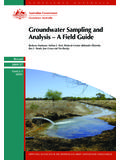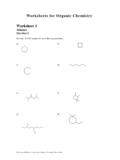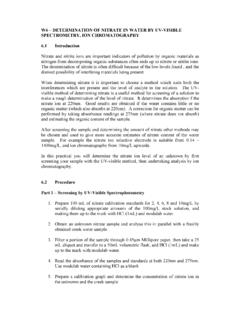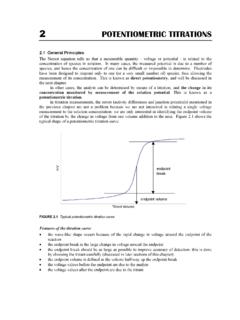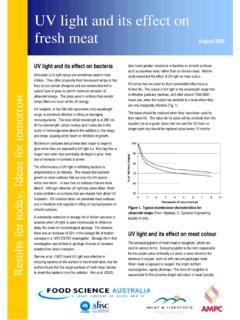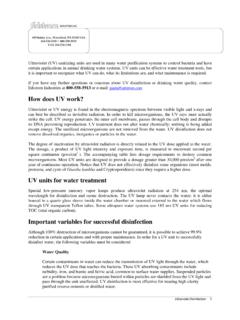Transcription of 3 UV-VISIBLE SPECTROSCOPY - cffet.net
1 3 UV-VISIBLE SPECTROSCOPY . Introduction Both molecular and atomic species can absorb radiation in the ultraviolet- visible (UV/VIS) regions of the electromagnetic spectrum by the absorption of energy by certain electrons in a substance. In this case, the ultraviolet region is considered to be above 200 nm. Different types of electrons, but not all types, can absorb UV/VIS radiation, depending on the type of substance, as shown in Table TABLE Types of electrons and their absorption behaviour Type of substance Type of electron Absorbs? Ion Inner shell No Outer shell (valence) Yes Covalently-bonded species Single bond No Double/triple bond Yes Unbonded Yes EXAMPLE Which of the following substances absorb UV/VIS radiation?
2 Hexane, hexene, trichloromethane, potassium chloride, iron (III) chloride, potassium nitrate Substance Absorb? Reason hexane No All covalent bonds are single hexene Yes Electrons in C=C absorb trichloromethane Yes Unbonded electrons on Cl potassium chloride No Both K+ and Cl- are no valence electrons iron (III) chloride Yes Fe3+ has valence electrons potassium nitrate Yes One of the covalent bonds in nitrate is a double bond, and oxygen has unbonded electrons CLASS EXERCISE State whether the following compounds would absorb photons from the ultraviolet- visible region: (a) sodium chloride (b) sodium sulfate (c) copper sulfate (d) benzene 3. UV-VISIBLE SPECTROSCOPY In general, the more absorbing electrons in a species, the higher the absorption wavelength will be.
3 Only a few absorbing electrons means that the compound will generally be colourless and absorb in the ultraviolet region only. For a compound to be coloured, there must be some absorption in the visible region. CLASS EXERCISE Which of the compounds giving the spectra below will be coloured? Instrumentation Colorimeters Colorimeters, in their most basic form, employ the human eye as a detector, and the human brain as a means of comparing the colour and intensity of samples. Solutions of equal concentration have the same colour and intensity. Not surprisingly, colorimeters, such as the Lovibond comparator, suffer from several disadvantages: a series of comparison standards must always be available;. the human eye responds only to radiation within the wavelength range of 400-700 nm.
4 The brain is unable to match absorbances if the solutions contain more than one coloured species;. and the eye is not sensitive to detect differences in intensity of less than 5%. The analysis of chlorine in swimming pools is very often done at poolside using a colorimeter, where a disc of standard colours (for different concentrations) is placed in one side of the instrument, and the sample (with a colouring agent for the chlorine) placed in the other. The user looks at both cells together and adjusts the standard disc until the colours match. Filter Photometers Filter photometers (sometimes incorrectly called colorimeters) are the simplest instrumental method of determining the concentration of a coloured substance.
5 They are only capable of measuring absorbance, not recording a spectrum. The wavelength selector in a such an instrument is a piece of absorbing material (eg coloured plastic) chosen to match the characteristics of the analyte. Normally, these instruments operate only in the visible region, because of the cheaper filters in that region. If a scanned spectrum is not required and there are no close together peaks, photometers can provide as accurate results as more expensive and complicated, and less rugged spectrophotometers. The design is relatively simple in either single- or double-beam form. A light source (generally a tungsten lamp) is defined in area by a simple optical system, before passing through a filter, which limits the wavelength range to that which will be absorbed by the sample solution.
6 After passing through the solution, the radiation intensity is measured by a detector. Sci Inst Analysis (Spectro/Chrom) 3. UV-VISIBLE SPECTROSCOPY These filter photometer are almost always single-beam, where the instrument is zeroed with a blank solution, and calibrated to 100% absorbance by shutting off the light path. The sample solution is then placed in the instrument and its absorbance measured. Tungsten Filter Sample Detector Readout lamp cell FIGURE Standard components of a filter photometer CHOOSING THE FILTER. The filters used in these photometers are generally supplied with the instrument, each transmitting a different range of the visible spectrum. Selection of the proper filter is vital: the filter should transmit (let through) the wavelengths that the analyte is capable of absorbing.
7 Otherwise, the "excess". radiation of wavelengths that will not be absorbed, will swamp the detection system. In Chapter 1, you learnt about the effect of absorption of visible light on the colour of a substance. To revise, the observed colour is the opposite of the absorbed colours. The colours of the visible region and their wavelength ranges are shown below. TABLE Colours and wavelengths Colour Wavelength range (nm). violet 400-450. blue 450-490. green 490-530. yellow 530-580. orange 580-620. red 620-800. When choosing a filter for use with a particular analyte solution, a knowledge of colour absorption and transmission is one way of determining the correct filter to use. However, a better method is to determine accurately the absorption spectrum of the analyte, and to use the basic rule: a filter should transmit where the sample is absorbing.
8 Figure shows the range of filters commonly available, the 600 series of numbers simply being manufacturer's code numbers. FIGURE Transmission spectra for commonly available filters Sci Inst Analysis (Spectro/Chrom) 3. UV-VISIBLE SPECTROSCOPY EXAMPLE (a) A red liquid is absorbing blue and green radiation, and transmitting red, orange and yellow. What colour should the filter be? What numbered filter (from Figure ) is appropriate? The filter must transmit where the sample is absorbing, ie, blue-green. The colour of a filter is the colour that is transmits: ie blue-green. This filter is chosen to absorb the unwanted red/orange/yellow light , and only let through the colours that the sample is absorbing. The best filter from Figure would be 603.
9 (b) The absorption spectrum of a compound is shown below. What coloured filter would be suitable for its analysis? What numbered filter (from Figure ) is appropriate? The substance is absorbing most strongly from 550-620nm. This covers the yellow and orange regions of the spectrum. Therefore, the filter would be yellow-orange. The best filter from Figure would be 606. CLASS EXERCISE (a) What is the best filter for the coloured species from Exercise (b) What colour regions would blue-green copper sulfate be absorbing? What filter (colour and code number) would be suitable for copper sulfate? Sci Inst Analysis (Spectro/Chrom) 3. UV-VISIBLE SPECTROSCOPY While filter photometers are generally small and inexpensive, the technique has also found application in an instrument of quite the opposite characteristics.
10 Known as an auto analyser, large numbers of samples are loaded into a carriage which is then sampled in a set order by a "robot" arm. A single sample is split into a number of sub-samples and passed through different channels which generate colour (if necessary) through mixing with appropriate reagents, and then carry out a photometric analysis using a set filter for the particular analyte. The filter system is used because it is a compact and cheap method of wavelength selection. The Technicon AutoAnalyser, the most widespread of this form of instrument, is an example of a multi-channel device, where many measurements at different wavelengths are taken simultaneously. As many as twelve channels, each measuring a different analyte, can be operated at the same time.
